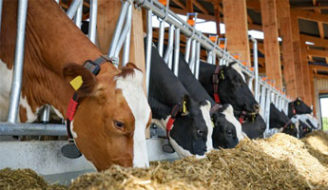
CPT 1 inhibition and ketosis of dairy cows
The ketosis is a severe metabolic disease in dairy cows with high milk production in the peripartum time phase. Today, this metabolic disease is next to milk fever and ruminal acidosis the most important disease with a incidence of approximately 12 % and leads to high annual culling rates and economical losses (Stehen, A. et al., J. Vet. Med. 44 (1997) 521-530). There is a growing body of evidence that the negative energy balance in early lactation leads to metabolic disturbances characterized by increased blood levels of ketone bodies (acetoacetate, 3-hydroxybutyrate) and decreased blood glucose.
The clinical signs are reduced food intake, central nervous symptoms until to lose consciousness. The milk production ceases and the cows become anorexic with liver injury. The increased concentrations of ketone bodies in the blood are a major cause for these signs. Today, there is no causal treatment of ketosis. The aim of treatments is to decrease the high ketone bodies in the blood, but none of the known therapeutic measures lower the ketones in a rapid and permanent way.
Etomoxir and the new oxirane carboxylic acids offer now a new therapeutic option. There are no drugs, with exception of insulin, that lower so rapid the ketones in the blood as these new substances. In experiments with ketotic cows (3-hydroxybutyrate: 4.0 – 5.5 mmol/l) it has been shown that 1.25 g of etomoxir, administered intravenously, reduced inert two hours the ketones up to 88 %. Such a low dose regiment and the opportunity to administer the drug in form of rumen-resistant capsules offer a practical and low-cost treatment for this economical important disease in farm animals.
